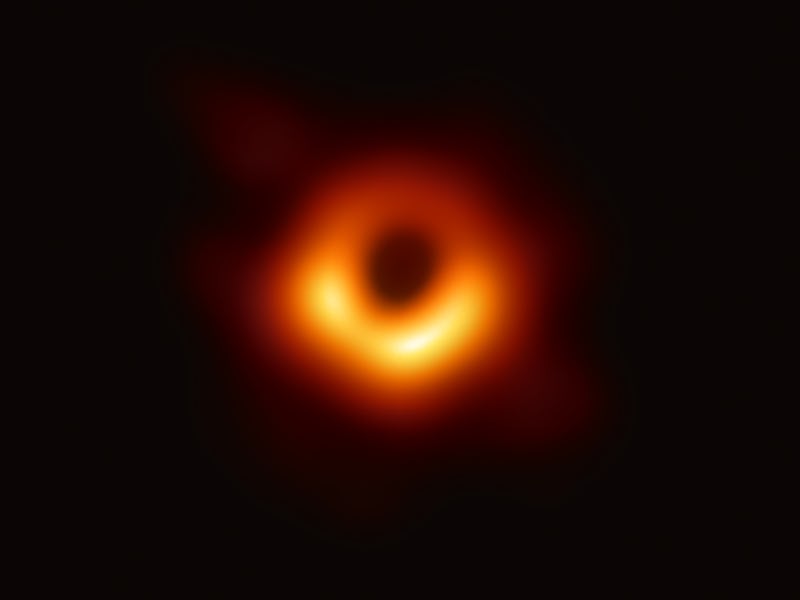Black holes’ infinite rings reveal how massive these cosmic behemoths really are
The rings are like ‘frames of a movie.’

Black holes are among the most massive objects in the universe, but by their very nature, they are shrouded in darkness, obscured from human view. But on April 10, 2019, the world got its first good glimpse of a black hole, revealing the behemoth surrounded by a bright, halo-like ring of light.
Now, a new study suggests that this ring of light may do more than shine a spotlight on these dark objects. It can also reveal just how massive black holes really are.
The paper, published Wednesday in the journal Science, describes how these infinite rings of light can be used as a tool to observe black holes and provide more precise measurements of their mass and spin.
Shining light
Light is made up of particles called photons. As it bends as a result of a black hole's gravitational pull, it forms what is called a "photon ring."
In the image of the black hole M87 captured by the Event Horizon Telescope, the photon ring appears infinite, as it is made up of a series of subrings based on the number of orbits the photons make around the black hole.
The photon rings appear increasingly sharp based on the number of times they orbited the black hole.
“Together, the set of subrings are akin to the frames of a movie, capturing the history of the visible universe as seen from the black hole,” the team of researchers say in the study.
In this way, the photon rings are essentially the fingerprint of the black hole they orbit, revealing key details like its mass, shape, and rotation.
For the study, the team created a simulation of black hole images at a higher resolution than ever before, and then broke down these images into a series of sub-images.
“With the current EHT image, we've caught just a glimpse of the full complexity that should emerge in the image of any black hole,” Michael Johnson, an astrophysicist at the Center for Astrophysics, Harvard and Smithsonian, and lead author of the study, said in a statement.
The simulated images helped the scientists connect what they know about photon rings around black holes in theory, and what they could achieve with higher-resolution observations of the photon rings.
Famous black hole
The black hole M87 is located in galaxy Messier 87, around 55 million light years away from Earth. It has a mass about 6.5 billion times that of the Sun.
The image of M87 taken in 2019 provided the strongest evidence to date of the existence of supermassive black holes.
“Black hole physics has always been a beautiful subject with deep theoretical implications, but now it has also become an experimental science," Alex Lupsasca, a researcher at the Harvard Society of Fellows, and one of the co-authors of the new study, said in a statement.
"As a theorist, I am delighted to finally glean real data about these objects that we've been abstractly thinking about for so long."
Universal Interferometric Signatures of a a Black Hole's Photon Ring.
Scientists believe that a black hole lies in the center of every galaxy. To measure the mass of these monstrous creatures, astronomers observe how stars or gas behave around the center of a galaxy. By measuring the speed of these objects as they orbit around the black hole, they can then use that data to deduce the properties of a black hole.
But the new study instead suggests that higher-resolution observations are needed for precise measurements of black holes. Adding one more telescope to the Event Horizon Telescope array, which already comprises eight telescopes across five continents, may be enough to get the high-resolution images researchers need to capture these photon subrings in all their glory — and reveal the true nature of the universe's cosmic behemoths, black holes.
Abstract: The Event Horizon Telescope image of the supermassive black hole in the galaxy M87 is dominated by a bright, unresolved ring. General relativity predicts that embedded within this image lies a thin “photon ring,” which is composed of an infinite sequence of self-similar subrings that are indexed by the number of photon orbits around the black hole. The subrings approach the edge of the black hole “shadow,” becoming exponentially narrower but weaker with increasing orbit number, with seemingly negligible contributions from high-order subrings. Here, we show that these subrings produce strong and universal signatures on long interferometric baselines. These signatures offer the possibility of precise measurements of black hole mass and spin, as well as tests of general relativity, using only a sparse interferometric array.